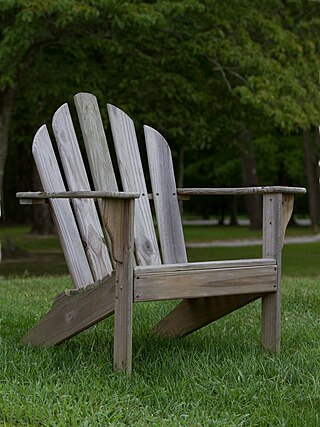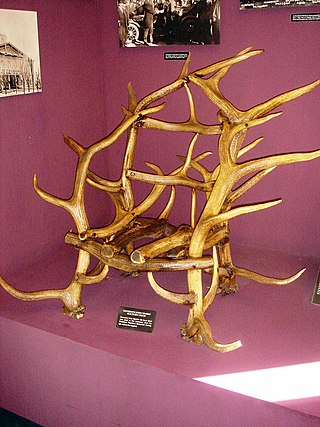
Furniture refers to objects intended to support various human activities such as seating, eating (tables), storing items, working, and sleeping. Furniture is also used to hold objects at a convenient height for work, or to store things. Furniture can be a product of design and can be considered a form of decorative art. In addition to furniture's functional role, it can serve a symbolic or religious purpose. It can be made from a vast multitude of materials, including metal, plastic, and wood. Furniture can be made using a variety of woodworking joints which often reflects the local culture.

The Eastlake movement was a nineteenth-century architectural and household design reform movement started by British architect and writer Charles Eastlake (1836–1906). The movement is generally considered part of the late Victorian period in terms of broad antique furniture designations. In architecture the Eastlake style or Eastlake architecture is part of the Queen Anne style of Victorian architecture.

Retro style is imitative or consciously derivative of lifestyles, trends, or art forms from history, including in music, modes, fashions, or attitudes. In popular culture, the "nostalgia cycle" is typically for the two decades that begin 20–30 years ago.

An antique is an item perceived as having value because of its aesthetic or historical significance, and often defined as at least 100 years old, although the term is often used loosely to describe any object that is old. An antique is usually an item that is collected or desirable because of its age, beauty, rarity, condition, utility, personal emotional connection, and/or other unique features. It is an object that represents a previous era or time period in human history. Vintage and collectible are used to describe items that are old, but do not meet the 100-year criterion.

Interior design is the art and science of enhancing the interior of a building to achieve a healthier and more aesthetically pleasing environment for the people using the space. An interior designer is someone who plans, researches, coordinates, and manages such enhancement projects. Interior design is a multifaceted profession that includes conceptual development, space planning, site inspections, programming, research, communicating with the stakeholders of a project, construction management, and execution of the design.

Upholstery is the work of providing furniture, especially seats, with padding, springs, webbing, and fabric or leather covers. The word also refers to the materials used to upholster something.
Shabby chic is a style of interior design that chooses either furniture and furnishings for their appearance of age and signs of wear and tear or distresses new ones to achieve the same result. Unlike much genuine period décor, this style features a soft, pastel-colored, cottage look.

A chest is a form of furniture typically of a rectangular structure with four walls and a removable or hinged lid, used for storage, usually of personal items. The interior space may be subdivided.
Campaign furniture is a type of furniture which is made for travel. Historically, much of it was made for military campaigns.

The Green Room is one of three state parlors on the first floor of the White House, the home of the president of the United States. It is used for small receptions and teas. During a state dinner, guests are served cocktails in the three state parlors before the president, first lady, and a visiting head of state descend the Grand Staircase for dinner. The room is traditionally decorated in shades of green. The room is approximately 28 by 22.5 feet. It has six doors, which open into the Cross Hall, East Room, South Portico, and Blue Room.

Distressing in the decorative arts is the activity of making a piece of furniture or object appear aged and older, giving it a "weathered look". There are many methods to produce an appearance of age and wear. Distressing is viewed as a refinishing technique although it is the opposite of finishing in a traditional sense. In distressing, the object's finish is intentionally destroyed or manipulated to look less than perfect, such as with sandpaper or paint stripper. For example, the artisan often removes some but not all of the paint, leaving proof of several layers of paint speckled over wood grain underneath. This becomes the "finished" piece.

A folding screen, also known as pingfeng, is a type of free-standing furniture consisting of several frames or panels, which are often connected by hinges or by other means. They have practical and decorative uses, and can be made in a variety of designs with different kinds of materials. Folding screens originated from ancient China, eventually spreading to the rest of East Asia, and were popular amongst Europeans.

Amish furniture is furniture manufactured by the Amish, primarily of Pennsylvania, Indiana, and Ohio. It is generally known as being made completely out of wood, usually without particle board or laminate. The styles most often used by the Amish woodworkers are generally more traditional in nature.

Rustic furniture is furniture employing sticks, twigs or logs for a natural look. The term “rustic” is derived from Latin “rusticus”. The style is rooted in Romantic tradition. In the US it is almost synonymous with the National Park Service rustic style of architecture. Many companies, artists and craftspeople make rustic furniture in a variety of styles and with a variety of historical and contemporary influences.
Italian Baroque interior design refers to high-style furnishing and interior decorating carried out in Italy during the Baroque period, which lasted from the early 17th to the mid-18th century. In provincial areas, Baroque forms such as the clothes-press or armadio continued to be used into the 19th century.

Horn furniture is a name given to furniture which is manufactured completely by shed antlers or pieces of furniture such as e.g. cabinets which are appliqued with antler elements such as carved horn roses or with antler pieces from tusks, fallow deer, stag and deer. Trophies of chase have already been used during the late Middle Age for furnishing and in modern times furniture makers use the horns and antlers of animals such as cattle, antelope, moose and elk.

Ancient furniture was made of many different materials, including reeds, wood, stone, metals, straws, and ivory. It could also be decorated in many different ways. Sometimes furniture would be covered with upholstery, upholstery being padding, springs, webbing, and leather. Features which would mark the top of furniture, called finials, were common. To decorate furniture, contrasting pieces would be inserted into depressions in the furniture. This practice is called inlaying.

An umbrella stand is a storage device for umbrellas and walking sticks. They are usually located inside the entrance of a home or public building, and are sometimes complemented by a hanger or mirror, or combined with a coat rack.
Vintage design refers to an item of another era that holds important and recognizable value. This style can be applied to interior design, decor, clothing and other areas. Vintage design is popular and vintage items have risen in price. Outlets of vintage design have shifted from thrift store to shabby chic stores.

An Irish dresser, sometimes known as a kitchen dresser, is a piece of wooden Irish vernacular furniture consisting of open storage or cupboards in the lower part, with shelves and a work surface, and a top part for the display of crockery, but also any objects of monetary or sentimental value.

















